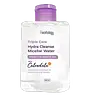What's inside
What's inside
 Key Ingredients
Key Ingredients

 Benefits
Benefits

 Concerns
Concerns

 Ingredients Side-by-side
Ingredients Side-by-side

Water
Skin ConditioningDipropylene Glycol
HumectantPolyglyceryl-4 Caprate
Emulsifying1,2-Hexanediol
Skin ConditioningMelaleuca Alternifolia Leaf Extract
PerfumingMelaleuca Alternifolia Flower/Leaf/Stem Extract
Skin ConditioningMelaleuca Alternifolia Leaf Water
AntimicrobialMelaleuca Alternifolia Leaf Oil
AntioxidantCentella Asiatica Extract
CleansingTrehalose
HumectantDiethoxyethyl Succinate
SolventBetaine
HumectantPolyglyceryl-3 Cocoate
EmulsifyingPolyglyceryl-6 Ricinoleate
EmulsifyingPolyglyceryl-6 Caprylate
EmulsifyingAllantoin
Skin ConditioningDisodium EDTA
Dipotassium Glycyrrhizate
HumectantHydroxyacetophenone
AntioxidantEthylhexylglycerin
Skin ConditioningWater, Dipropylene Glycol, Polyglyceryl-4 Caprate, 1,2-Hexanediol, Melaleuca Alternifolia Leaf Extract, Melaleuca Alternifolia Flower/Leaf/Stem Extract, Melaleuca Alternifolia Leaf Water, Melaleuca Alternifolia Leaf Oil, Centella Asiatica Extract, Trehalose, Diethoxyethyl Succinate, Betaine, Polyglyceryl-3 Cocoate, Polyglyceryl-6 Ricinoleate, Polyglyceryl-6 Caprylate, Allantoin, Disodium EDTA, Dipotassium Glycyrrhizate, Hydroxyacetophenone, Ethylhexylglycerin
Water
Skin ConditioningButylene Glycol
HumectantDisodium Cocoamphodiacetate
CleansingBetaine
HumectantSodium Chloride
MaskingSodium Glycolate
BufferingDMDM Hydantoin
PreservativeAllantoin
Skin ConditioningTetrasodium EDTA
Citric Acid
BufferingGlycerin
HumectantCalendula Officinalis Flower Extract
MaskingPropylene Glycol
HumectantPanthenol
Skin Conditioning1,2-Hexanediol
Skin ConditioningPentylene Glycol
Skin ConditioningSodium Benzoate
MaskingPotassium Sorbate
PreservativeSodium Acetylated Hyaluronate
HumectantSodium Hyaluronate
HumectantSodium Hyaluronate Crosspolymer
HumectantPyridoxine
Skin ConditioningThiamine Hcl
MaskingHydrolyzed Sodium Hyaluronate
Skin ConditioningEthylhexylglycerin
Skin ConditioningAscorbic Acid
AntioxidantBioflavonoids
Skin ConditioningBiotin
AntiseborrhoeicCyanocobalamin
Skin ConditioningFolic Acid
Skin ConditioningGlutathione
Menadione
MaskingRiboflavin
Cosmetic ColorantTocopheryl Acetate
AntioxidantWater, Butylene Glycol, Disodium Cocoamphodiacetate, Betaine, Sodium Chloride, Sodium Glycolate, DMDM Hydantoin, Allantoin, Tetrasodium EDTA, Citric Acid, Glycerin, Calendula Officinalis Flower Extract, Propylene Glycol, Panthenol, 1,2-Hexanediol, Pentylene Glycol, Sodium Benzoate, Potassium Sorbate, Sodium Acetylated Hyaluronate, Sodium Hyaluronate, Sodium Hyaluronate Crosspolymer, Pyridoxine, Thiamine Hcl, Hydrolyzed Sodium Hyaluronate, Ethylhexylglycerin, Ascorbic Acid, Bioflavonoids, Biotin, Cyanocobalamin, Folic Acid, Glutathione, Menadione, Riboflavin, Tocopheryl Acetate
 Reviews
Reviews

Ingredients Explained
These ingredients are found in both products.
Ingredients higher up in an ingredient list are typically present in a larger amount.
1,2-Hexanediol is a synthetic liquid and another multi-functional powerhouse.
It is a:
- Humectant, drawing moisture into the skin
- Emollient, helping to soften skin
- Solvent, dispersing and stabilizing formulas
- Preservative booster, enhancing the antimicrobial activity of other preservatives
Allantoin is a soothing ingredient known for its protective and moisturizingg properties. Because of this, it is often added to products with strong active ingredients.
Studies show higher concentrations of this ingredient can promote wound healing.
Though it can be derived from the comfrey plant, allantoin is produced synthetically for cosmetic products to ensure purity.
Learn more about AllantoinBetaine is a common humectant (a substance that promotes retention of moisture). It's known to be gentle on the skin and can help balance hydration.
This ingredient is best for improving hydration and soothing irritated skin. Studies also show it helps even out skin tone.
Fun fact: Betaine is naturally created in the skin and body. The kind found within cosmetic products can be either plant-derived or synthetic.
Another name for betaine is trimethylglycine.
Learn more about BetaineEthylhexylglycerin (we can't pronounce this either) is commonly used as a preservative and skin softener. It is derived from glyceryl.
You might see Ethylhexylglycerin often paired with other preservatives such as phenoxyethanol. Ethylhexylglycerin has been found to increase the effectiveness of these other preservatives.
Water. It's the most common cosmetic ingredient of all. You'll usually see it at the top of ingredient lists, meaning that it makes up the largest part of the product.
So why is it so popular? Water most often acts as a solvent - this means that it helps dissolve other ingredients into the formulation.
You'll also recognize water as that liquid we all need to stay alive. If you see this, drink a glass of water. Stay hydrated!
Learn more about Water